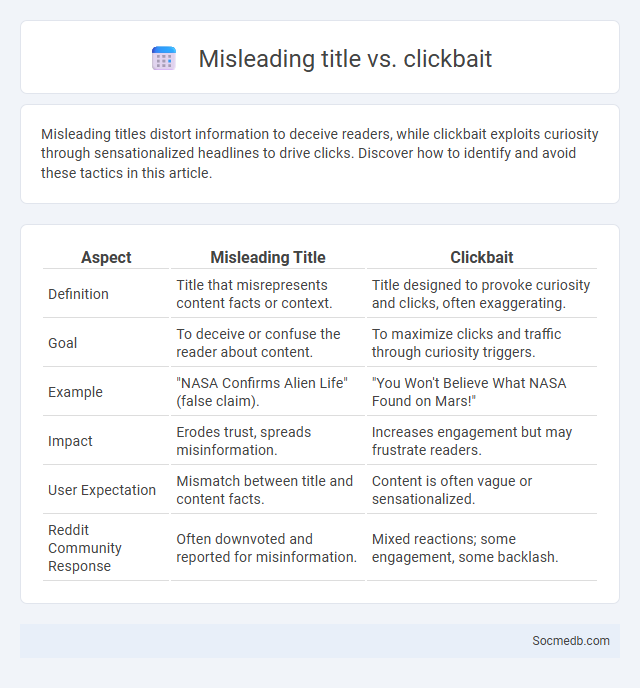
Photo illustration: misleading title vs clickbait
Misleading titles distort information to deceive readers, while clickbait exploits curiosity through sensationalized headlines to drive clicks. Discover how to identify and avoid these tactics in this article.
Table of Comparison
| Aspect | Misleading Title | Clickbait |
|---|---|---|
| Definition | Title that misrepresents content facts or context. | Title designed to provoke curiosity and clicks, often exaggerating. |
| Goal | To deceive or confuse the reader about content. | To maximize clicks and traffic through curiosity triggers. |
| Example | "NASA Confirms Alien Life" (false claim). | "You Won't Believe What NASA Found on Mars!" |
| Impact | Erodes trust, spreads misinformation. | Increases engagement but may frustrate readers. |
| User Expectation | Mismatch between title and content facts. | Content is often vague or sensationalized. |
| Reddit Community Response | Often downvoted and reported for misinformation. | Mixed reactions; some engagement, some backlash. |
Understanding Misleading Titles
Misleading titles on social media often rely on sensationalism and ambiguity to attract clicks, which can distort the actual content and misinform audiences. Analyzing the language and context of these titles helps identify exaggerations or false implications, improving media literacy and critical thinking. Platforms like Facebook and Twitter have implemented algorithms to flag or reduce the visibility of misleading headlines, aiming to enhance content credibility and user trust.
Defining Clickbait: What Sets It Apart
Clickbait is characterized by sensationalized headlines designed to attract clicks by exploiting curiosity gaps without delivering proportional value. Unlike standard content, clickbait manipulates emotional triggers and often exaggerates facts to increase engagement metrics such as click-through rates and session duration. This tactic undermines content credibility and user trust, distinguishing clickbait from legitimate digital marketing strategies.
Rule Violations in Online Content
Rule violations in online content on social media platforms can include hate speech, misinformation, harassment, and graphic violence, which violate community guidelines designed to maintain a safe environment. Your posts and interactions are routinely monitored through automated systems and user reports to detect and remove such content swiftly. Failure to adhere to these rules may result in warnings, content removal, temporary bans, or permanent account suspension.
Key Differences Between Misleading Titles and Clickbait
Misleading titles often present inaccurate or exaggerated information that fails to reflect the actual content, eroding your trust and credibility, while clickbait deliberately entices users with sensational headlines to generate clicks regardless of relevance or truth. Misleading titles may unintentionally confuse readers due to poor framing, whereas clickbait strategically manipulates curiosity for viral engagement and advertising revenue. Understanding these key differences empowers you to critically evaluate social media content and avoid falling for deceptive tactics.
Common Examples of Misleading Titles
Misleading titles on social media often use clickbait phrases such as "You won't believe what happened next" or exaggerate facts to attract more views and shares. These titles commonly distort the original content by implying false urgency, emotional manipulation, or sensationalism to boost engagement. Your ability to critically evaluate headlines is essential to avoid falling for deceptive information and spreading misinformation online.
How Clickbait Tricks Audiences
Clickbait manipulates social media audiences by using sensational headlines and misleading images designed to spark curiosity and prompt clicks. These tactics exploit psychological triggers such as fear of missing out (FOMO) and emotional arousal, often leading you to engage with superficial or irrelevant content. Understanding these strategies helps protect your attention from being exploited and encourages more critical consumption of online information.
Platform Policies on Title Rule Violations
Social media platforms enforce strict policies on title rule violations to maintain content integrity and user trust, often flagging or removing posts with misleading, inappropriate, or spammy titles. These platforms utilize automated algorithms and human moderators to detect violations, applying penalties such as reduced visibility, account warnings, or temporary suspensions. Compliance with title guidelines ensures improved content discoverability and adherence to community standards across networks like Facebook, Twitter, and Instagram.
Impact of Misleading Titles on Audience Trust
Misleading titles on social media significantly erode audience trust by creating false expectations and fostering skepticism toward content sources. When You encounter sensationalized headlines that do not deliver accurate information, it diminishes your confidence in both the platform and the creator. Consistent exposure to such deceptive tactics causes users to question the credibility of genuine posts, leading to decreased engagement and overall content distrust.
Ethics: Navigating Between Clickbait and Compliance
Navigating the ethics of social media requires balancing engaging content with truthful representation to avoid misleading clickbait tactics. Platforms must enforce robust compliance policies that protect users' trust and promote authentic interactions. You can contribute by critically evaluating content and sharing responsibly to uphold digital integrity.
Best Practices for Creating Accurate Content Titles
Crafting accurate content titles for social media involves incorporating targeted keywords that reflect the core message and improve searchability on platforms like Facebook, Instagram, and Twitter. Using clear, concise language ensures users immediately understand the content's value, boosting engagement and click-through rates. Avoiding clickbait and misleading phrases maintains audience trust and supports long-term brand credibility across social media channels.
 socmedb.com
socmedb.com